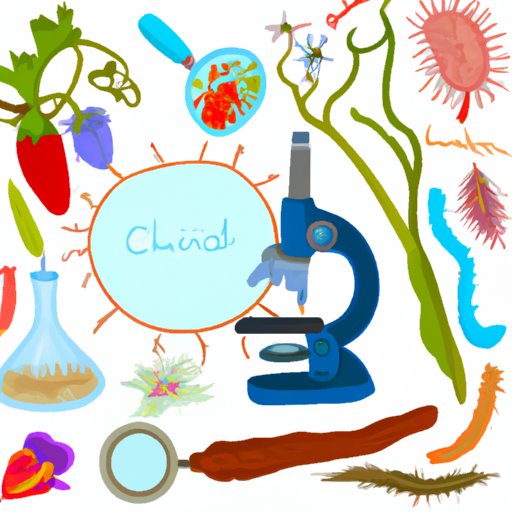Introduction
Living organisms are all around us, from the tiniest cells that make up our bodies to the massive ecosystems that support life on Earth. Understanding what an organism is and how it fits into the larger picture of life on our planet is essential for anyone interested in biology or ecology. In this article, we will explore the characteristics of organisms, the different types of organisms, and the impact that humans are having on life as we know it. By the end, you should have a better understanding of what an organism is and why it matters.
Exploring the Basics: What is an Organism?
An organism is any living thing that can maintain basic functions such as growth, reproduction, and responding to stimuli. Organisms can be plants, animals, fungi, bacteria, or any other form of life. They are characterized by features such as cells, the ability to obtain and utilize energy, and the capacity for complex adaptations through evolution.
It is important to note that not all living things are organisms, and some nonliving things can also exhibit certain characteristics of living things. For example, viruses are not considered organisms because they cannot reproduce or carry out metabolic processes without a host cell. Similarly, fire is not an organism, although it does exhibit properties of life such as consuming resources and creating waste.
From Cells to Ecosystems: Understanding the Complexity of Organisms
Organisms can be studied and understood at many different levels, from the smallest parts of cells to the larger functions of ecosystems. The basic unit of life is the cell, which contains all the necessary components for a living organism to function. Cells can work together to form tissues, organs, and ultimately organisms.
Organisms rely on many different systems to sustain life, including the respiratory, circulatory, and nervous systems in animals. These systems work together to carry out essential functions like oxygenation of cells, removal of waste products, and response to environmental stimuli. An organism can also adapt to its environment through natural selection and genetic variations that allow it to survive in changing conditions, such as developing longer fur in cold climates.
The Diversity of Life: Examining the Many Types of Organisms
There are millions of species of organisms on our planet, each with unique characteristics and roles in the larger ecosystem. Biodiversity, or the variety of life on Earth, is essential for maintaining stable ecosystems and supporting human well-being.
Organisms can be broadly classified into two categories: unicellular and multicellular. Unicellular organisms, like bacteria and protozoa, consist of a single cell. Multicellular organisms, like plants and animals, are composed of multiple cells that work together to perform specific functions. Within each category, there is a vast diversity of species, each with unique adaptations and traits that allow it to thrive in certain environments.
The History of Life: Tracing the Evolutionary Origins of Organisms
Over billions of years, life on Earth has evolved in response to changing environmental conditions and selective pressures. The first single-celled organisms emerged around 3.8 billion years ago and paved the way for more complex life forms.
As organisms evolved, major events such as the development of photosynthesis and the colonization of land led to the rise of new species and ecosystems. Through natural selection, certain traits that conferred a survival advantage became more prevalent, ultimately giving rise to the diversity of life we see today.
Organisms in Crisis: Discussing the Threats Facing Living Things Today
Human activity is having a significant negative impact on the organisms that make up our planet. Climate change, habitat destruction, pollution, and overexploitation of resources are just a few of the threats facing life on Earth today.
As habitats are destroyed and populations decline, the loss of biodiversity can have severe consequences for ecosystems and human societies. For example, the extinction of pollinators like bees and butterflies could severely impact food production and natural habitats for other organisms. Climate change is also driving shifts in ecosystem composition and causing mass extinction events at an alarming rate.
The Future of Life: Considering the Possibilities for Organismal Research
New innovations in synthetic biology, gene editing, and biotechnology have the potential to revolutionize the study of organisms and the way we interact with them. Synthetic biology involves the engineering of biological systems to carry out specific functions, creating new organisms or changing existing ones. Gene editing allows scientists to selectively modify DNA to treat genetic diseases or create new traits in organisms.
The possibilities of these techniques are both exciting and potentially perilous. They offer the potential for breakthroughs in areas like medicine and agriculture but also carry significant ethical and ecological implications that must be considered carefully.
Conclusion
Organisms are the foundation of life on Earth, and understanding them is essential to understanding the larger picture of ecology and biology. From the basics of what makes an organism to the complex systems that allow it to thrive, there is much to be learned about the organisms that make up our planet.
As we move forward as a society, it is crucial to consider the impacts of our actions on the organisms that share our planet. By working to protect and preserve biodiversity, we can create a better world for all living things.
